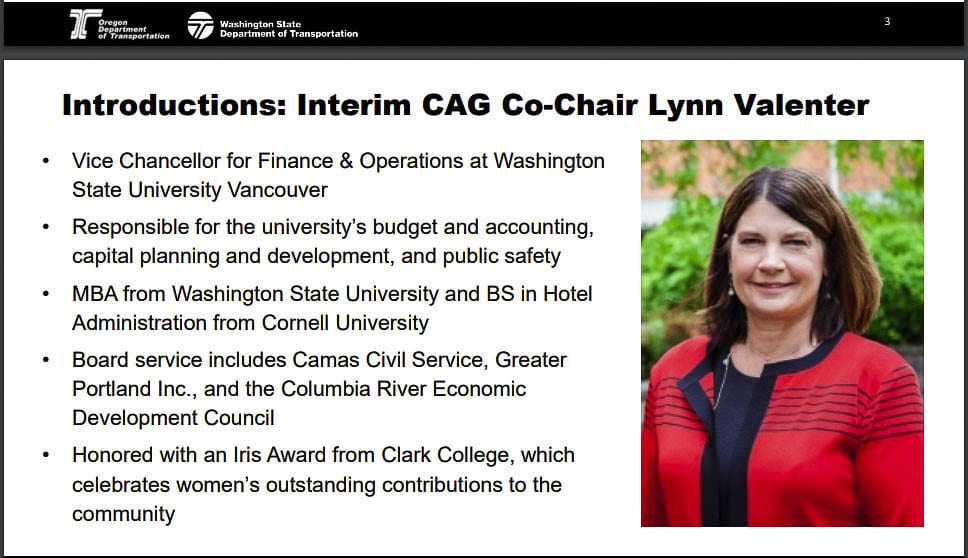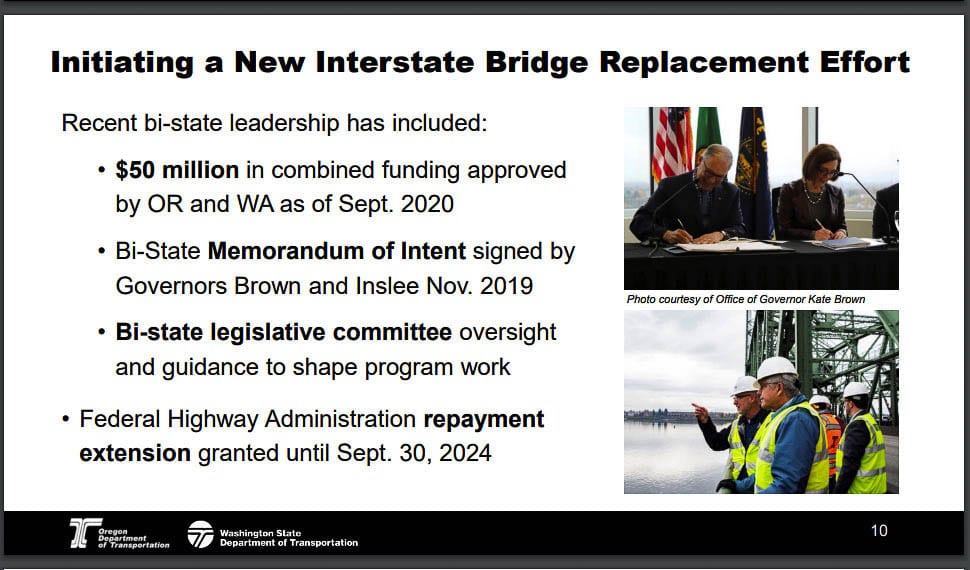Multiple advisory groups will be created to offer input with less than four years to project start
Last Friday, the 12 members of the Interstate Bridge Replacement Program (IBRP) Executive Steering Group (ESG) held a three-hour online meeting. There were three major topics for the meeting. Equity considerations and standing up a community forum; opportunity for public input; and confirming topics for their next meeting.
The membership of the ESG is a series of twos. Two Departments of Transportation (DOT) — WSDOT & ODOT; two mayors — Portland and Vancouver; two transit agencies — TriMet and C-TRAN; two ports — the ports of Portland and Vancouver; two regional transportation agencies — METRO and RTC; and members of community advisory groups — one Oregon and one Washington.

The most important item on the agenda appeared to be the “Problem Statement.” This describes the problem to be solved by the project.
The problem statement included the seismic vulnerability of the existing bridge, limited public transportation, inadequate bicycle and pedestrian facilities, impared freight movement, safety concerns due to the aging structure and existing roadway design, congestion constraints, economic vitality, and increasing operations and maintenance costs.
Yet there was no real discussion regarding the details of the problem statement, nor whether they should be expanded, modified, or reduced. The final proposal will be measured against the problem statement to determine the success or failure of the project.
Clark County Today recently examined the need for public transportation mentioned in the second bullet point. You can read that story here.
Increasing traffic congestion is a major concern of regional drivers. A past PEMCO survey indicated 94 percent of people prefer to use their personal vehicles. This Clark County Today piece lays out the data.
Second, an April 2019 Oregon Transportation Commission survey found 51 percent of citizens want to “expand and improve interstates and interstate bridges.” Another 14 percent want expanded arterials.
Third, Metro’s 2019 poll showed people’s top priority is roads and highways. The Portland Tribune summarized: “On its own, improving public transit is a lower priority than making road improvements and the more overarching goal of easing traffic — voters still overwhelmingly rely on driving alone to get around,” reads the poll’s conclusions.
In opening remarks, Vancouver Mayor Ann McEnerny-Ogle said: “I was thinking that I’m at the table simply because if we do nothing, this bridge will fail and fall into the river with severe consequences to the economic vitality of our entire region. I’m excited to see that the partners around the table are committed to a successful quick completion of this work.”
Her reference to “quick completion” was highlighted by Greg Johnson, IBRP Administrator. The two states have committed $50 million in total funding to the project, according to Johnson. The deadline granted by the Federal Highway Administration is an extension until Sept. 30, 2024.
The ESG spent a great deal of time talking about equity and community involvement. “So ESG is the first step; the community advisory group; and we’re also looking to establish an equity group,” said Johnson..”These will be the three pillars of consensus and moving issues forward back to the program team.”
Lynn Valenter was introduced as a co-chair of the Community Advisory Group (CAG). She is presently vice chancellor for Finance & Operations at Washington State University Vancouver. Valenter will work with Ed Washington from Oregon. He is the director of Outreach and Community Engagement in Global Diversity & Inclusion for Portland State University, and was the first African-American elected to the Metro Council, where he served from 1991-2001
The CAG will potentially consist of 25 members representing various interest groups around the metro region. There was also a mention of Topical Work Groups (TWG) and a Technical Advisory Group (TAG). There is also the Bi-State Bridge Committee of 16 elected representatives from Oregon and Washington. Some observers have questioned how any viable solution can be created and advanced in less than four years, when there are so many committees and subgroups all supposedly making input and advising the ESG and Johnson’s IBRP team.
The draft Charter of the ESG stated: “The ESG recognizes that ultimate authority for IBRP decisions will vary based on the issue and could rest with the Program Administrator and DOTs, legislatures, other transportations agencies with jurisdictional authority (local, state and federal), transportation commissions, and governors of each state.”

Administrator Johnson shared they must give a progress report to both legislatures as well as a conceptual finance plan, by Dec. 1. By June 30, 2021 they have to show significant progress toward the beginning of the federal environmental process.
Regarding equity, Johnson shared that they have established a goal of 15 percent of the project will be awarded to meet the federal Disadvantaged Business Enterprise (DBE) program. “The consultant team has done a fantastic job, they committed to surpassing the mandatory 15% DBE involvement goal. They set a voluntary goal of 20% for themselves.”
Johnson mentioned the hiring of their primary consultant for the project.
“We had a competitive process to bring on a general engineering consulting firm WSP, which is an international engineering consulting firm was selected as the prime consultant in closed partnership with parametrics,” he said. “The great thing about these firms is they have a great familiarity, not only with the region, but with this project as many of many of their members worked on the original CRC. Now folks would take that as a red flag, I take it as they understand what the process was and where it failed and why it failed. So bringing that and being unshackled by the history of the past project is going to be tremendously important.”
There was no discussion regarding a finance plan. However included in the agenda was a “Draft – Conceptual Executive Steering Group Issues List.” Included among 18 bullet points was “Finance plan strategies, including tolling.”
The Draft Issues List elaborated. “Given the funding reality for similarly large transportation projects nationwide, it is acknowledged that a bridge replacement program will require revenue from a diverse array of sources, including tolling, state funds from both Oregon and Washington, and federal funds.”
There was no discussion about the issues list, nor of the tolling or finance plan. In the $3.5 billion Columbia River Crossing (CRC), federal funding contributed $850 million to pay for the light rail extension into Vancouver. There was potentially an additional $400 million from a different federal program that many felt was a questionable source of revenue. The balance of the CRC’s funding came from Oregon and Washington ($450 million each), and then borrowed funds, paid for with tolling revenues.
Citizens can provide public input to the ESC via email at interstatebridge@wsdot.wa.gov and state “ESG Public Comment” in the subject line. Or people can leave a phone message by calling (360) 905-1560 and saying “ESG public comment” in your message.
The next meeting of the ESG will be Nov. 30.




